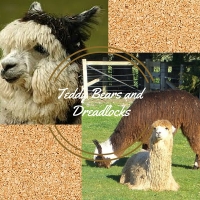

Teddy Bears and Dreadlocks. The Two Types of Alpacas
 Posted by SLN Staff on May 25th, 2016 | Comments Off on Teddy Bears and Dreadlocks. The Two Types of Alpacas
Posted by SLN Staff on May 25th, 2016 | Comments Off on Teddy Bears and Dreadlocks. The Two Types of Alpacas 

Teddy Bears and Dreadlocks
Have you ever seen an alpaca and thought, whoa. That looks different than the one I’ve seen before? There’s actually only two types of alpacas; suri alpacas and huacaya alpacas. Suri’s fleece’s look like dreadlocks and huacaya’s have the fluffy qualities of a teddy bear! Here we looked around the web to find a couple of great resources that explain some history of alpacas and the major differences between the two breeds!
“Centuries ago, the powerful Inca empire focused its many religious and ritualistic practices around the llama and alpaca. In Incan culture, alpaca fiber was reserved for royalty. The Incan term aluascay refers to cloth woven from llama and guanaco fiber and worn by commoners. Gami, refers to alpaca cloth worn by high ranking officials and nobility, and cumbi (probably meaning exclusive or special) referred to vicuna cloth. In their drive to acquire precious metals during the Conquest, the Spanish measured the wealth of the Inca empire by its gold and silver. To the Inca, status and wealth were in cloth. In all of human history, there may have been nothing like the Incan obsession with fine cloth. Fabric, often made of alpaca, was the medium in which Inca society defined it’s essence. The entire civilization with its ingenious eye for detail and organization put its best efforts into fine fiber and beautiful textiles.”
Source: http://www.marylandalpacas.org/pages/suris_huacayas.html
Here we dive into the official name of the teddy bear alpaca, huacayas! These great resources will talk about the breed and the value behind the beautiful huacaya fleece.
“The Ideal Huacaya Fleece
The ideal huacaya fleece should be: fine, dense, uniform, and grow perpendicular to the skin. The fleece, which grows from individual follicles in the skin, should be made up of defined staples of crimpy “bundled” fleece. These bundles should organize themselves into staples which create a dense presentation across the animal. The huacaya alpaca should be well covered with a soft, uniform fleece, except on the ears and the bridge of the nose of mature animals. The muzzle and ears should be soft to the touch.

Source
The elite alpaca has a well-defined crimp in their top knot, which continues down the neck, into the blanket the belly, and on to the tail. There should be very little medulation. The fleece should be well-nourished, exhibit a brightness or sheen, and be void of dull, dry, chalky fiber. The ideal huacaya will produce fleece as soft and as fine as cashmere. Huacaya alpaca is spun into luxury garments that can be worn close to the skin.”
Source: http://www.alpacas.com/alpacalibrary/idealalpaca.aspx
Last but not least, suri alpacas. The fleece on this animal grows not like the teddy bear quality of the huacaya fleece but instead hangs down like dreadlocks. They are rarer than the huacaya alpaca but just as beautiful.
“About Suri Alpacas”
“Among the people of the Andes, the woven fabric from the fleece of the alpaca was so soft and alluring that it was used as currency. The Suri alpaca has unique fiber characteristics that distinguish the Suri from the rest of the camelid family. Unlike the soft fuzzy look of the Huacaya alpaca, the Suri’s long, separate, distinctive locks are comprised of twisted or flat fibers that drape down the sides of the Suri’s body. The Suri’s fiber has a cool, slick hand; soft as cashmere, warmer than wool, with the luster of silk.

The first Suri’s were imported to the United States from Bolivia in the winter of 1991. Subsequent imports came in 1993, 1995, 1996 and 1998 from Peru, Chile, and Bolivia. Worldwide, Suri’s account for only about 15% of the total alpaca population and are so rare that there may be fewer of them than the vicuna, the wild ancestor of the alpaca.”
Source: http://www.surinetwork.org/AboutSuriAlpacas
Conclusion
There we have it huacaya and suri breeds of alpacas. Both are beautiful and have many uses for their amazing fiber. Would you like to learn more about alpacas and alpaca farming? Click here to book a meeting with us.
Related Articles





